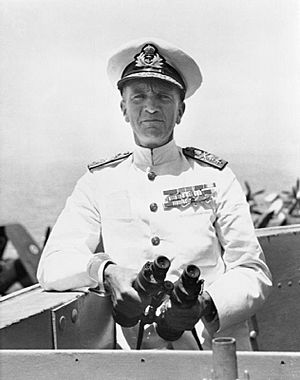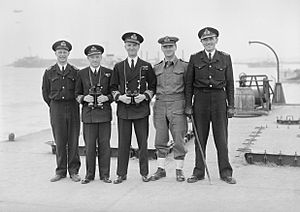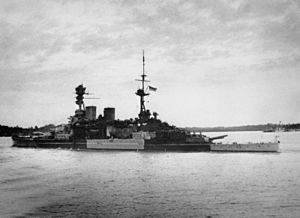William Tennant (Royal Navy officer) facts for kids
Quick facts for kids
William Tennant
|
|
|---|---|

Vice Admiral Tennant visiting HMS Colossus, May 1945
|
|
| Birth name | William George Tennant |
| Nickname(s) | "Dunkirk Joe" |
| Born | 2 January 1890 Upton-upon-Severn, Worcestershire, England |
| Died | 26 July 1963 (aged 73) Worcester, Worcestershire, England |
| Allegiance | |
| Service/ |
|
| Years of service | 1905–1949 |
| Rank | Admiral |
| Unit | Force Z |
| Commands held | HMS Arethusa HMS Repulse America and West Indies Station |
| Battles/wars | |
| Awards | Knight Commander of the Order of the Bath Commander of the Order of the British Empire Member of the Royal Victorian Order Legion of Merit (United States) |
| Other work | Lord Lieutenant of Worcestershire |
Admiral Sir William George Tennant (1890–1963) was a brave British naval officer. He is famous for leading the successful rescue mission at Dunkirk in 1940. This mission saved over 300,000 soldiers during World War II.
Later, Tennant was the captain of the battlecruiser HMS Repulse. His ship was part of a group that searched for German warships in the Atlantic Ocean. Sadly, the Repulse was sunk by Japanese forces in 1941. This happened along with HMS Prince of Wales in the South China Sea. After this, he helped build special floating harbours and fuel pipelines for the D-Day invasion.
Contents
William George Tennant was born in Upton-upon-Severn, England, in 1890. He went to Hanley Castle Grammar School nearby. At just 15 years old, he joined the Royal Navy in 1905. He started his training as a naval cadet at the Britannia Royal Naval College.
He quickly moved up the ranks. By 1909, he was an acting sub-lieutenant. In 1912, he became a lieutenant. He chose to specialize in navigation, which means guiding ships.
Tennant's Service in World War I
During the First World War, Tennant served on several ships. He was on destroyers like Lizard and Ferret. These ships were part of the Harwich Force. Later, he served on cruisers such as Chatham and Nottingham. He was part of the Grand Fleet.
He survived a major event in 1916 when the Nottingham was sunk. After that, he returned to the Harwich Force. He served on the cruiser Concord until 1919.
Between the World Wars
After World War I, Tennant continued to advance. In 1920, he became a lieutenant-commander. He served as the Navigating Officer on the battlecruiser Renown. This was during a royal trip to India and Japan in 1921-1922. The trip was with Edward, Prince of Wales.
He then taught at HMS Dryad, a navigation school. In 1924, he went back to sea. He was the navigating officer for the Repulse during another royal tour. This time, the Prince of Wales visited Africa and South America. For his excellent service, King George V made him a Member of the Royal Victorian Order in 1925.
Tennant became a commander in 1925. He worked at the British Admiralty, which is like the navy's headquarters. He was part of the Operations Division. He later served as an Executive Officer on the cruiser Sussex in the Mediterranean. In 1930, he joined the staff at the Royal Naval College, Greenwich. He was promoted to captain in 1932.
From 1935, he commanded the cruiser Arethusa in the Mediterranean. Then, in 1937, he became an instructor at the Imperial Defence College in London. In 1939, just before World War II began, he became the Chief Staff Officer to the First Sea Lord.
World War II Heroics
The Dunkirk Evacuation: "Dunkirk Joe"
On May 26, 1940, Captain Tennant was given a very important job. He was made the Senior Naval Officer ashore at Dunkirk. He went to Dover and took charge of a naval team. This team had eight officers and 160 men. They sailed on the destroyer Wolfhound. Their mission was to help with the Dunkirk evacuation.
Over 300,000 British and French soldiers were trapped on the beaches of Dunkirk. France had fallen to the Nazis. Tennant's job was to organize these soldiers and get them onto the ships waiting to rescue them. He stayed until the very last ships left on June 2. He walked the beaches with a megaphone, calling out for any remaining British troops.
Tennant was highly praised for his amazing efforts at Dunkirk. He received the Companion of the Order of the Bath award. The sailors under his command admired him so much that they nicknamed him "Dunkirk Joe."
Captain of the Repulse
On June 28, 1940, Tennant became the captain of the battlecruiser Repulse. He led his ship in battles against powerful German battleships. These included the Scharnhorst and Gneisenau. Later, the Repulse was part of the hunt for the famous battleship Bismarck.
The Sinking of the Repulse
In December 1941, Captain Tennant and the Repulse joined Force Z. This naval group, led by Admiral Sir Tom Phillips, was sent to Singapore. Their goal was to stop Japan's advance in the Pacific Ocean.
On December 8, the day after the attack on Pearl Harbor, Japanese planes attacked Singapore. Force Z left to attack a Japanese convoy near Malaya. However, this operation was soon called off. When they returned to Singapore, they learned that Japanese forces had landed in Malaya. Force Z, without air cover, headed back to Malaya to fight them.
On December 10, the Japanese attacked Force Z. Captain Tennant skillfully avoided nineteen torpedoes dropped by Japanese aircraft. But the Repulse was eventually hit by a "pincer attack" and took five torpedoes. The ship sank in just twenty minutes. Many crew members were lost. Captain Tennant and other survivors were rescued by HMAS Vampire, one of the destroyers in Force Z.
In February 1942, he was promoted to rear-admiral. In 1943, he was recognized for his part in operations in Madagascar.
Helping with the Normandy Invasion

In June 1944, Tennant was put in charge of a huge naval project. He oversaw the transport, assembly, and setup of the two Mulberry harbours. These were artificial floating harbours. They were vital for landing supplies and troops during the D-Day invasion of Normandy.
In August, he supervised the laying of the Pluto pipelines. These underwater pipelines carried much-needed fuel from England to France. This fuel was crucial for the ongoing battles. For his important work in the success of the Normandy invasion, King George VI awarded Tennant the Commander of the Order of the British Empire. He also received the United States Legion of Merit.
Life After the War
Tennant continued to serve after World War II. He was promoted to vice-admiral in 1945. He was also made a Knight Commander of the Order of the Bath for his war service. In 1946, he became commander of the North America and West Indies Station. He was promoted to admiral in 1948 and retired in August 1949.
In 1950, he was named Lord Lieutenant of Worcestershire. This was a special role representing the King in his home county. He held this position until he passed away in 1963.
Tennant in Film
Captain Tennant's actions have been shown in movies and TV.
- In the 2004 TV series Dunkirk, he was played by Adrian Rawlins.
- In the 2017 Christopher Nolan film Dunkirk, the character of Commander Bolton, played by Kenneth Branagh, was inspired by Captain Tennant's brave leadership during the evacuation.
Awards and Honours
Sir William Tennant received many awards for his service.
United Kingdom Honours
| Honour | Abbreviation/Title | Date Awarded |
|---|---|---|
| Member of the Royal Victorian Order | MVO | October 16, 1925 |
| Companion of the Order of the Bath | CB | June 7, 1940 |
| Commander of the Order of the British Empire | CBE | November 28, 1944 |
| Knight Commander of the Order of the Bath | KCB | December 18, 1945 |
Awards from Other Countries
| Award | Country |
|---|---|
| Croix de guerre 1939-1945 | France |
| Légion d'honneur, Officier | France |
| Grand Cross of the Order of George I | Greece |
| Commander of the Legion of Merit | USA |
Images for kids
-
Rear Admiral Tennant (center) with his officers on Mulberry B, Arromanches, July 1944




